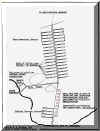|

The Navy
Tunnel
© 1999 Edward Michaud
|
During my visit to the island I had the
opportunity to tour the Malinta Tunnel system in detail with one of the
local islanders who was very familiar with its internal arrangements. Just
before we entered the main gate he requested that I bring along our
Pulse-Detection unit, which I didn't hesitate to agree with. I had
previously heard of some of the legends associated with this vast cavern and
what he then told me sounded so very plausible.
He stated
that in 1987, when he was acting as a tour-guide for a rather large group of
American war veterans, an older gentleman pulled him aside and related an
incident that occurred in 1942. This man was assigned to the American 59th
Coast Artillery at the time of the Japanese offensive. Just prior to the
surrender the cases of American paper currency, then under storage inside
the tunnels, were systematically burned in an incinerator just outside the
western entrance of the Malinta tunnel. This old veteran further stated that
he was in charge of one of those ‘burning cans’ and that there simply wasn’t
enough time to completely destroy the millions of five, ten, and 20 dollar
notes and gold certificates. As a result, some of the soldiers who were
designated for the currency-destruction details buried small cashes of the
money all around the Malinta Hill and San Jose area.
According to
this man, he found an empty five-inch powder canister close to one of the
artillery batteries and carried it back to his allotted space within the
tunnels. After stuffing the empty shell with wads of gold certificates,
five-dollar notes, a few military documents and his personal war journal, he
sealed the opening with a thick coat of wax. He then proceeded to dig a hole
in the center of the Fourth lateral midway down the length of the
compartment and ultimately buried the canister, covering the item with small
rocks and mortar.
This veteran
stated that as far as he knew his little deposit was still there as he never
had the opportunity to return for it and spent the next three years in a
series of Japanese prisoner of war camps.
Needless to
say, the certificates and notes would be of considerable value today, but
the personal and military documents that he mentioned would be worth even
more to military and Government historians. The detector that I used within
the tunnel system, however, picked up everything – including the reinforcing
steel within the concrete floors and walls. It was impossible to
differentiate between construction materials and disassociated items. It is
still not known whether this particular story is actually true or not, but it
sounds reasonable enough.*
|

